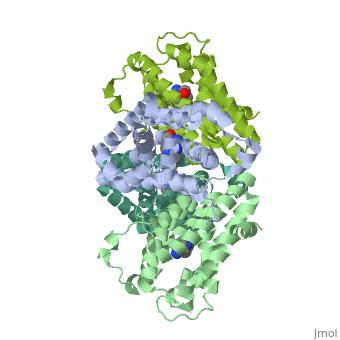1yak
From Proteopedia
Complex of Bacillus subtilis TenA with 4-amino-2-methyl-5-hydroxymethylpyrimidine
Structural highlights
FunctionTENA_BACSU Stimulates the production of several extracellular degradative enzymes at the transcriptional level, probably by interfering with DegS and DegU, which are required for this effect. Is not an essential protein, but affects the sporulation frequency. Evolutionary ConservationCheck, as determined by ConSurfDB. You may read the explanation of the method and the full data available from ConSurf. Publication Abstract from PubMedBacillus subtilis gene products TenA and TenI have been implicated in regulating the production of extracellular proteases, but their role in the regulation process remains unclear. The structural characterization of these proteins was undertaken to help provide insight into their function. We have determined the structure of TenA alone and in complex with 4-amino-2-methyl-5-hydroxymethylpyrimidine, and we demonstrate that TenA is a thiaminase II. The TenA structure suggests that the degradation of thiamin by TenA likely proceeds via the same addition-elimination mechanism described for thiaminase I. Three active-site residues, Asp44, Cys135, and Glu205, are likely involved in substrate binding and catalysis based on the enzyme/product complex structure and the conservation of these residues within TenA sequences. We have also determined the structure of TenI. Although TenI shows significant structural homology to thiamin phosphate synthase, it has no known enzymatic function. The structure suggests that TenI is unable to bind thiamin phosphate, largely resulting from the presence of leucine at position 119, while the corresponding residue in thiamin phosphate synthase is glycine. Structural characterization of the regulatory proteins TenA and TenI from Bacillus subtilis and identification of TenA as a thiaminase II.,Toms AV, Haas AL, Park JH, Begley TP, Ealick SE Biochemistry. 2005 Feb 22;44(7):2319-29. PMID:15709744[1] From MEDLINE®/PubMed®, a database of the U.S. National Library of Medicine. See AlsoReferences
| ||||||||||||||||||||


